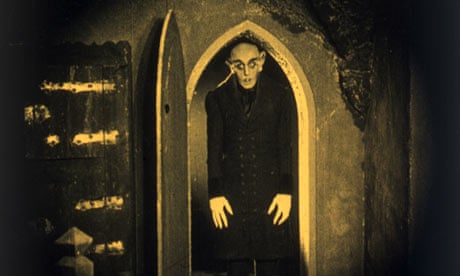Sex and death, those two great mainstays of the horror genre, have rarely been as poetically evoked as in FW Murnau's silent masterpiece. If Nosferatu wasn't quite the first vampire movie, it was the first adaptation of Dracula, albeit an unofficial one; Bram Stoker's estate sued the producers and all copies of the film were ordered to be destroyed.
Fortunately for the history of cinema it was an order that could not be enforced in Germany. The film follows the story of Dracula closely, though names have been changed. The Dracula character, Graf Orlok, was played by Max Schreck as a hideous walking corpse with a bald head, pointy teeth and long fingernails; Jonathan Harker becomes Thomas Hutter, Mina Harker is Ellen, Renfield is Knock and Van Helsing becomes Professor Bulwer.
As Hutter travels to Carpathia to meet Orlok for the first time, his crossing of the boundary between the real world and the nightmare one is marked by the famous inter-title, so beloved of André Breton and the surrealists: "And when he crossed the bridge, the phantoms came to meet him." After glimpsing Hutter's portrait of Ellen, Orlok makes his way, with a stash of earth-filled coffins, from Varna on the Black Sea to Bremen (called Wisborg in the film) in north Germany – an epic voyage by sea, and the sort of vast geographical distance that has been diminished by subsequent Dracula films as the globe has been shrunk by air travel and telecommunications.
Many of what would become conventions of vampire pictures were established here – the vampire's thirst for blood, the power of sunlight to destroy the creature and vampirism as a metaphor for sexuality, contagion and xenophobia.
Despite Orlok's hideousness, the Mina character sacrifices herself to him with an erotic abandon notably absent from her relations with her human husband, and the vampire is unable to tear himself away from her neck before sunrise. Orlok, like so many monsters before and since, is finally undone by his all-too-human desire.
